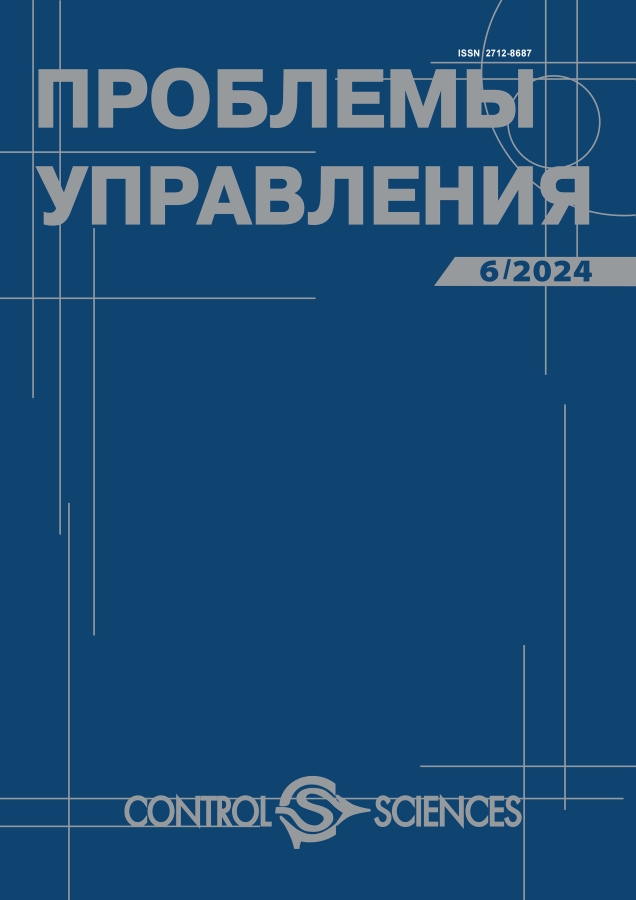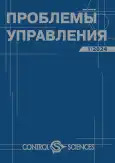АНАЛИЗ АГРЕГАЦИОННОГО ПОВЕДЕНИЯ МОБИЛЬНЫХ РОБОТОВ В АЛГОРИТМЕ СТАЙНОГО УПРАВЛЕНИЯ ПРИ ЕСТЕСТВЕННЫХ ОГРАНИЧЕНИЯХ
- Авторы: Ефремов А.Ю1
-
Учреждения:
- Институт проблем управления им. В. А. Трапезникова РАН
- Выпуск: № 1 (2024)
- Страницы: 79-89
- Раздел: Управление подвижными объектами и навигация
- URL: https://journals.rcsi.science/1819-3161/article/view/264570
- DOI: https://doi.org/10.25728/pu.2024.1.7
- ID: 264570
Цитировать
Полный текст
Аннотация
Ключевые слова
Список литературы
- Schmickl, T., Hamann, H. BEECLUST: A Swarm Algorithm Derived from Honeybees // In: Bio-Inspired Computing and Communication Networks, ed. by Y. Xiao. – Boca Raton, FL: CRC Press, 2011. – P. 95–137.
- Reynolds, C.W. Flocks, Herds and Schools: a Distributed Behavioral Model // Computer Graphics. – 1987. – Vol. 21, no. 4. – P. 25–34.
- Katada, Y. Evolutionary Design Method of Probabilistic Finite State Machine for Swarm Robots Aggregation // Artificial Life Robot. – 2018. – Vol. 23. – P. 600–608.
- Firat, Z., Ferrante, E., Gillet, Y., Tuci, E. On Self-organised Aggregation Dynamics in Swarms of Robots with Informed Robots // Neural Comput. Appl. – 2020. – Vol. 32. – P. 13825–13841.
- Gia, Luan, P., Truong Thinh, N. Self-organized Aggregation Behavior Based on Virtual Expectation of Individuals with Wave-Based Communication // Electronics. – 2023. – Vol. 12, no. 10. – Art. no. 2220.
- Gasparri, A., Priolo, A., Ulivi, G. A Swarm Aggregation Algorithm for Multi-robot Systems Based on Local Interaction // Proc. of the IEEE International Conference on Control Applications. – Dubrovnik, 2012. – P. 1497–1502.
- Khaldi, B., Harrou, F., Cherif, F., Sun, Y. Self-Organization in Aggregating Robot Swarms: A DW-KNN Topological Approach // Biosystems. – 2018. – Vol. 165. – P. 106–121.
- Misir, O., Gökrem, L. Flocking-Based Self-organized Aggregation Behavior Method for Swarm Robotics // Iran J. Sci. Technol. Trans. Electr. Eng. – 2021. – Vol. 45. – P. 1427–1444.
- Martínez-Clark, R., Cruz-Hernández, C., Pliego-Jimenez, J., Arellano-Delgado, A. Control Algorithms for the Emergence of Self-organized Behaviours in Swarms of Differential-Traction Wheeled Mobile Robots // International Journal of Advanced Robotic Systems. – 2018. – Vol. 15, no. 6. – P. 1–14.
- Olfati-Saber, R. Flocking for Multi-agent Dynamics Systems: Algorithms and Theory // IEEE Trans. on Automatic Control. – 2006. – Vol. 51, no 3. – P. 401–420.
- Couzin, I., Krause, J., James, R., et al. Collective Memory and Spatial Sorting in Animal Groups // Journal of Theoretical Biology. – 2002. – Vol. 218, no. 1. – P. 1–11.
- Costanzo, M., Hemelrijk, C.K. Spontaneous Emergence of Milling (Vortex State) in a Vicsek-like Model // Journal of Physics D: Applied Physics. – 2018. – Vol. 51, no. 13. – Art. no. 134004.
- Кирикова Е.П., Павловский В.Е. Моделирование управляемого адаптивного поведения гомогенной группы роботов // Искусственный интеллект. – 2002. – № 4. – С. 596–605. [Kirikova, E.P., Pavlovskii, V.E. Modelirovanie upravlyaemogo adaptivnogo povedeniya gomogennoi gruppy robotov // Iskusstvennyi intellect. – 2002. – No. 4. – P. 596–605. (In Russian)]
- Rochefort, Y., Piet-Lahanier, H., Bertrand, S. Guidance of Flocks of Vehicles Using Virtual Signposts // Preprints of the 18th IFAC World Congress. – Milano, 2011. – P. 5999–6004.
- Ballerini, M., Cabibbo, N., Candelier, R., et al. Interaction Ruling Animal Collective Behavior Depends on Topological Rather Than Metric Distance: Evidence from a Field Study // Proceedings of the National Academy of Sciences. – 2008. – Vol. 105, no. 4. – P. 1232–1237.
Дополнительные файлы











